
Image credit: NASA/Sandra Joseph and Kevin O'Connell Nov. 16, 2009.
Downloaded from http://www.nasa.gov/mission_pages/shuttle/shuttlemissions/sts129/multimedia/gallery/09-11-16-4.html Dec 26 2011
| HPS 0410 | Einstein for Everyone |
Back to main course page
John
D. Norton
Department of History and Philosophy of Science
University of Pittsburgh
Here are the questions that were asked in the description in the course catalog... Answered.

Image credit: NASA/Sandra Joseph and Kevin
O'Connell Nov. 16, 2009.
Downloaded from
http://www.nasa.gov/mission_pages/shuttle/shuttlemissions/sts129/multimedia/gallery/09-11-16-4.html
Dec 26 2011
YES
| According to Einstein's special theory of
relativity, all processes slow down when a
system moves at high speed. The result applies to
astronauts since they are moving rapidly. The amount of slowing is
so slight as to be imperceptible for ordinary speeds. It becomes
very significant when we get close to the speed of light: |
An astronaut is really just a quick way of saying "someone who travels away from the earth at high speed and returns." |
| Car at 100 miles per hour | Rocket at earth's escape velocity (7 miles per second) |
Rocket at 100,000 miles per second (53% speed of light) |
Rocket at 185,800 miles per second (99% speed of light) |
| Lose 0.35 seconds in 1,000,000 years | Lose 0.022 seconds in 1 year
(Astronaut is 0.022 seconds younger on returning after a one year trip.) |
Astronaut metabolism slows to 84% of normal. | Astronaut metabolism slows to 4.5% of normal. (One year journey=aging 16 days) |
| Small effect... | ...large effect |
How can special relativity know that these effects will happen? They arise directly from the basic supposition of the theory: all uniformly moving observers must measure the same speed for light.--186,000 miles per second.
At first this seems impossible. Say I send out a light signal from earth. I measure its speed at 186,000 miles per second.
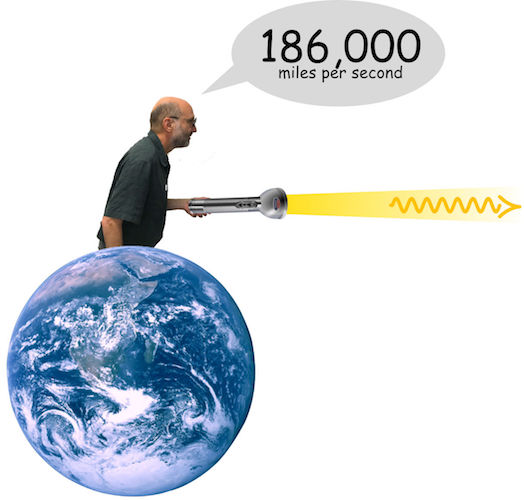
What about another observer that chases after the light signal at, say, half the speed of light? Shouldn't that observer see the light signal slowed to half its speed? All our common sense says yes. Special relativity says no.

How can that be? Something in our common sense assumptions must be wrong. There is not much room to look for the mistake. We find the speed of the light signal with just two instruments: a measuring rod to determine how far the light signal goes; and a clock to measure how long it takes to go that far. Classically we assume that neither is affected by rapid motion. At least one of these assumptions must be wrong if the speed of light is to remain constant. When we work through the details we find that both are: the rod shrinks in the direction of motion and the clock slows.
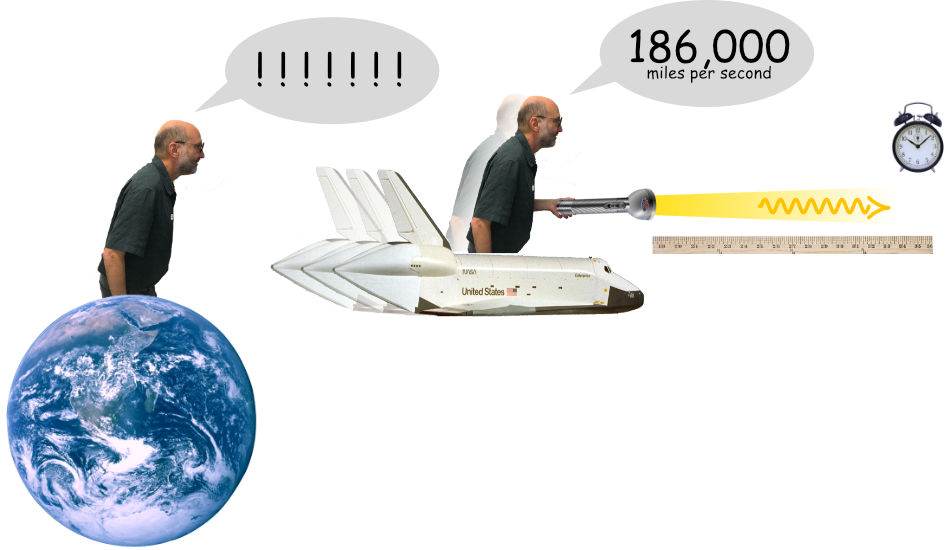
So rapidly moving clocks slow. How does that get to a
rapidly moving astronaut aging more slowly. An
astronaut's metabolism is a clock. You can use your pulse to time
things if you like. So that metabolism clock must slow too. The legend is
that Galileo used his pulse to time the period of a slowly swinging lamp
while not attending to a cathedral mass and thereby arrived at the famous
result of the isochrony of the pendulum, which just says that the period
of a pendulum is fixed by its length. His pulse was the simple clock used
to time the pendulum.
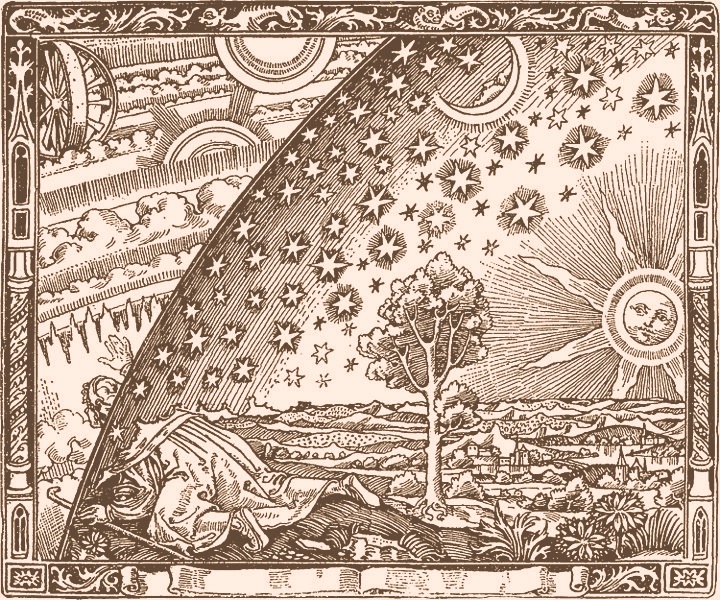
Contrary to appearances, this is not a
medieval woodcut, but a 19th century wood engraving mimicking the
medieval style.
Downloaded from Wikimedia
http://en.wikipedia.org/wiki/File:Flammarion.jpg
YES
Can both be possible at the same time? Can you run out of
space in the sense that you count off all the cubic miles--but you never
come to an edge?

Image credit: NASA
http://solarsystem.nasa.gov/multimedia/display.cfm?IM_ID=9643
Both can indeed happen in a more restricted way in a very
familiar example. Consider motions on the surface of
the earth. If you start in Pittsburgh, choose any direction you
like and keep moving straight ahead, you will eventually come back to
where you started. There will be no edge for you to fall off. So the
surface of the earth has the sort of properties we are looking for. It is
finite in area. It is just 196,000,000 square miles. But it has no edge.
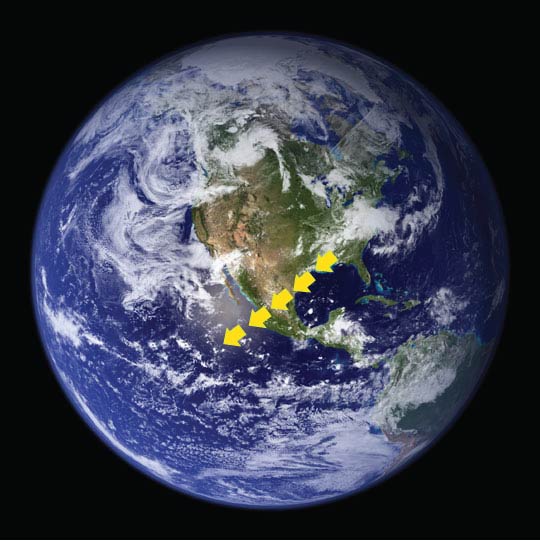

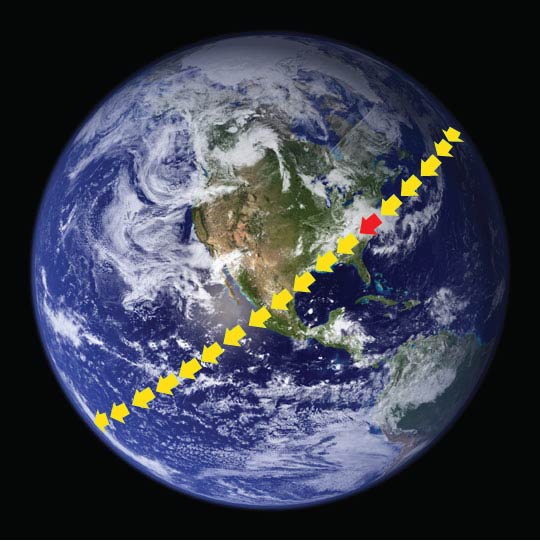
http://eoimages.gsfc.nasa.gov/images/imagerecords/57000/57723/globe_west_540.jpg
Of course the example seems strained. While we come back
to where we started, we are really not going in a straight line, but in a
big circle. While the two dimensional surface of the earth is finite
without edge, it gets these properties because it is really curved into a
third dimension.
Does that fact really make such a difference to the
possibility of a surface of finite area but no edge? What
if
we were flat beings trapped in the two dimensional surface of the earth,
unable to sense the existence of this third dimension. All we know about
the surface of the earth was what can be read off our two dimensional
maps. Then all we would know was that we lived in a finite two dimensional
space with no edge. That a third dimension might have something to do with
this, to us would be speculation of little practical importance. We would
have no way of accessing this third dimension.
Could the analogous thing happen for a three dimensional space? One of the big discoveries of 19th century geometry was that this is entirely possible. To get us started, imagine that there is a fourth dimension of space into which our three dimensions curve. Then we might end up with a three dimensional space which has finite volume but no edge. No matter which way you voyage in a spaceship, you will eventually come back to where you started, without hitting an edge.

http://eoimages.gsfc.nasa.gov/images/imagerecords/57000/57723/globe_west_540.jpg
http://apod.nasa.gov/apod/image/0602/rs_ophiuci_021606_f.jpg
| We satisfied ourselves that this is possible by imagining a fourth dimension of space. How seriously should we take this fourth dimension? Our two dimensional surface dwellers could ignore the possibility of a third dimension in doing their geometry. All that mattered to them were the geometrical facts of the earth's surface that they could measure. In the three dimensional case, it is the same. All that matters are the geometrical facts about our three dimensional space that are accessible to us three dimensional beings. In the end, this fourth dimension of space becomes a comfortable fable to help us get used to the idea that a finite three dimensional space without edge is entirely possible. | There is a more sophisticated way to understand this fourth dimension. We might wonder whether there is some hidden logical inconsistency in a space of finite area or volume, but without an edge. We consider the surface of a sphere like our earth and see that it is finite in area but has no edge. That surface lives in an ordinary three-dimensional geometry. We think that geometry is logically consistent. So it follows that the geometry of the spherical surface in it must also be logically consistent. The same thinking applies to the higher dimensional space. We think the geometry of a four-dimensional Euclidean space is logically consistent. Hence the geometry of the three dimensional spherical space in it is also consistent, even though it has finite volume and no edge. |
In the 19th century, this sort of space was an interesting
mathematical curiosity. In 1917, shortly after Einstein had completed his
general theory of relativity, he proposed that our cosmic space was really
like this. This was the first relativistic cosmology.
Whether space has this structure remains one of the most interesting of
the open questions of modern cosmology. In Einstein's original universe,
space had a finite volume:
1,000,000,000,000,000,000,000,000,000,000 cubic light
years
That's a one followed by 30 zeros. But there is no edge.
![]()
![]()
![]()








YES
At first this seems impossible. If time has a beginning, there must be a first event or at least a clustering of events near it. Surely something must have happened before them?
Einstein's cosmology of 1917 was the first of many ever stranger cosmologies to be devised on the basis of his general theory of relativity. Einstein's first universe was static in time. The cosmologies that followed, starting in the 1920s, were not. They portrayed space itself as continually expanding. We can think of Einstein's universe as a three dimensional analog of a two dimensional spherical surface, somewhat like a balloon. Then this expansion simply corresponds to the inflation of the balloon.
Here is a picture of this expansion. The universe is represented by a sphere and time advances up the screen. So the small universe of long ago grows up the page to the universe of the present. |
Now imagine this expansion in reverse. As we look further and further back in time, the balloon gets smaller and smaller. In the typical cosmologies considered nowadays, not too long into the past the balloon would have shrivelled to nothing. At that point in our story, space would have ceased to be. One might try to image times before that moment. But it would be futile, since there is no space associated with the time. Indeed there is something highly suspect about the moment at which the balloon shrivels to a point. Then the curvature of the space becomes infinite and the basic equations of Einstein's theory break down. This first moment is not really a moment in time at all. It really amounts to a lower bound on our projections into the past. If we think of it as "time=0," then only moments with a time coordinate greater than 0 have physical meaning. It is the beginning of time and is otherwise known at the "big bang." |
To see why it is the "big bang", let us return our
imagination to the forward direction and imagine what happens around the
beginning of the expansion. Take any moment you like, as close as you like
to the big bang. By choosing that moment closer and closer to the big
bang, you can make space shrivel up as close to a point in size as you
like. From that moment, everything--space and all
its matter-- explodes outwards. All this happened not so long
ago. It was around 10 billion years ago.
YES
The "yes" is intriguing, but there is a catch. The
question did not ask if there really is time travel;
it asked only if it is possible. Something can be possible without
actually happening. It is possible for our earth to have two moons. In
fact it has only one.
While we have no evidence that time travel actually
occurs, all our latest work in theories of space and time tell us that it
is entirely possible. Broadly speaking, there
are two senses of time travel, both possible.
| 1. The first sense is the the H. G. Wells sense. This one is named after the author of the most famous story about time travel in which a voyager hops into a machine and travels about in time. Special relativity has room for something close. If we had things that traveled faster than light, then, for some observers, they would travel backwards in time. These faster than light objects are "tachyons." For some observers, they would leave today and arrive yesterday. | The effects that bring this about are closely
related to those that lead to the slower aging of rapidly moving
astronauts. That effect depended on rapidly moving clocks not
behaving as we expected. The time travel effect arises from
anomalies in how observers in rapid motion set their clocks at
different places in space |
| Of course how we could get ourselves to travel faster than light is an unsolved problem! We cannot accelerate through the speed of light. But is there some way to recreate ourselves traveling faster than light? If so, some observers would judge us to be traveling backwards in time. |  |
"There was a young lady named Bright,
Whose speed was far faster than light.
She set out one day
In a relative way,
And returned home the previous night."
--Arthur Henry Reginald
Buller.
2. The second sense is more topological and has been called "Goedelian" (by John Earman) in honor of the great logician Kurt, Goedel, who was a friend of Einstein's and did pioneering work on spacetimes that admit time travel.
|
We can imagine space and time as forming a huge sheet of paper. the vertical line is the complete history through time of a person, experiencing the years ..., 1980, 1981, ... etc. |
| What Einstein did in 1917 was to get us to wrap up the sheet of paper in the spatial direction so travel in the direction "left" is wrapped around to meet travel in the direction "right". That way we always end up where we started. |
| What Einstein's theory also allows is
that travel into the future of time can be
wrapped around to connect with the past, so that if we
persist long enough in time we end up back at the present. |
This is not a type of time travel that we create with a
machine. There's no device we can build that could somehow turn our
spacetime into one that has this global structure. The best
advice to someone who wants to travel in time this way is that
they should be sure to be born into the right universe! However there are
special circumstances that might bring about the wrapping around of future
into the past at least locally. It might happen near black holes generated
by gravitational collapse. It also may happen if we get very dense, very
rapidly rotating matter.

YES
This "yes" depends upon quantum mechanics, in whose founding Einstein played a major role. It is our best theory of matter and is usually applied to deal with matter in the very small, that is, little particles like electrons. It tells us that matter in the very small has properties quite unlike the ones we are used to with ordinary objects.
We are used to the idea that ordinary objects are either particles or waves. It turns out that in the small, particles are both particles and waves. They have a dual character that is quite preplexing when you first learn of it and, as far as I can tell, that perplexity never really goes away, even if you know a lot about them.
| Take electrons, for example. They are familiar to us
from old-fashioned television tubes. The electrons are fired from a
glowing element at the back of the tube. They are formed into a beam
by deflecting magnetic fields. When the electron is in flight in the beam, it behaves just like a wave. It spreads out in space, has a wavelength and frequency and can produce all sorts of wavelike phenomena, like interference patterns. These are just like the rippled patterns that water waves make on the surface of a pond when pebbles are dropped in. We can only get them because the waves are spread out in space. |
| When these electrons strike the screen of the TV tube, they behave very differently. According to the standard text book accounts of quantum mechanics, they instantly cease to be wave. They collapse to a point, so they are now behaving like a particle. We see that localization through the emitting of a brief flash of light from just one point on the screen. (Many of those flashes combine to make the images we watch.) |
So sometimes an electron behaves like a wave; and sometimes like a
particle. So what? The odd part is what decides whether the electron
behaves like a wave or a particle. In the standard text book treatments, we
decide by the act of observing the electron. An electron left to
itself behaves like a wave. The moment we observe it--for example by
having it smash into the screen of a TV tube so that we can see where it
is from the flash of light produced--then it behaves like a particle.
That means that the second picture is incomplete. The electron will only cede its wavelike character if there is someone there observing it. Only then does it collapse.
 |
That is the odd part. Standard, text book quantum
mechanics tells us that the act of our observing the electron has caused
it to collapse to a point. This astonishing idea troubled
Einstein very greatly and he could never accept it. What
difference does it make to the electron if we observe it or not?
What Einstein also saw was that the difficulty could not be confined to minute objects like electrons. If individual particles have this dual wave-particle, then so do collections of particles. Our observing of them will also cause them to collapse. Big objects like steam locomotives, moons and planets are just many, many particles all in one place. They will also have a slight wave character, too small for us to notice, but there nonetheless. And when we observe them, they will collapse!

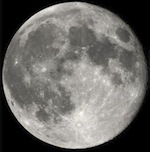 ...
...  ...
... 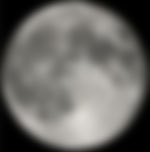 ...
... 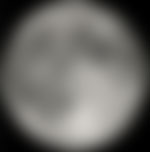 ...
...
... 
 ...
...
His collaborator and biographer Abraham Pais reports
"...during one walk, Einstein suddenly stopped, turned to
me, and asked whether I really believed that the moon
exists only when I look at it."
Abraham Pais, Subtle is the Lord.
Oxford: Clarendon Press, 1982. p.5.
The famous physicist (and inventor of the name "black hole") John Wheeler
also reported of Einstein
"...No one can forget how he expressed his discomfort about the role of
the observer, 'When a mouse observes, does
that change the state of the universe?' "
John A.Wheeler, "Memoir", pp. 21-22 in A. P.
French, Einstein: A Centenary Volume. Cambridge: Harvard Univ.
Press, 1979, on p. 22.
The question above is a combination of these two remarks and the answer of
yes is just standard text book physics.

Copyright John D. Norton. February, 2002; July 2006; January 3, 2007, December 29, 2011, January 5, 2012, January 5, 2015. August 29, 2018. svg images entered January 11, 2022.